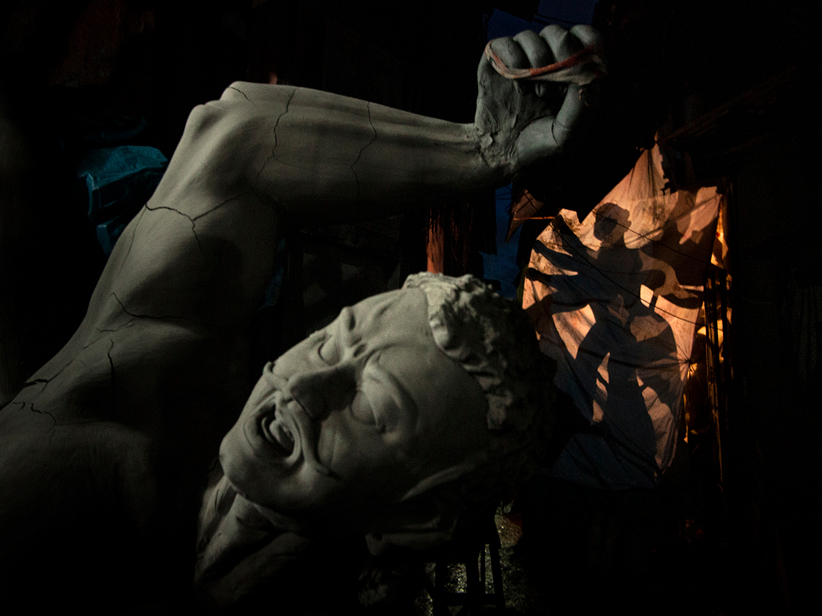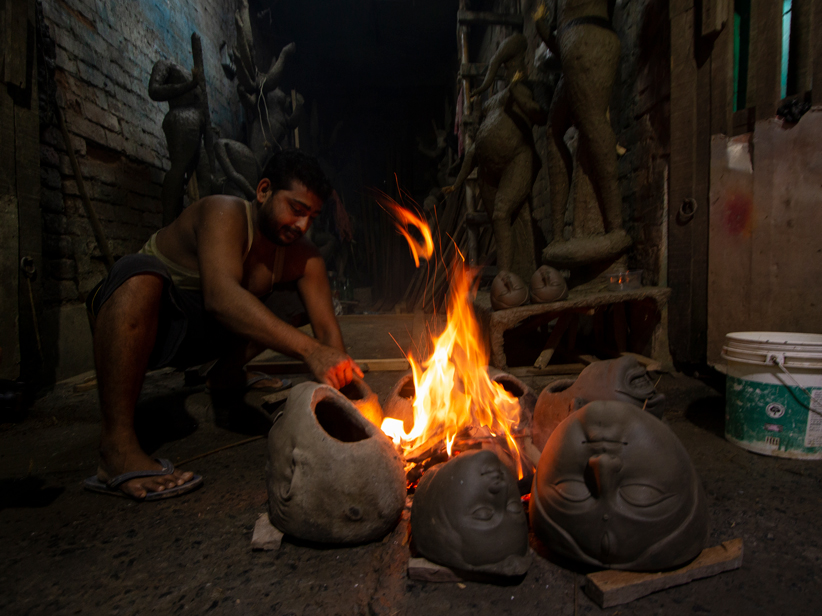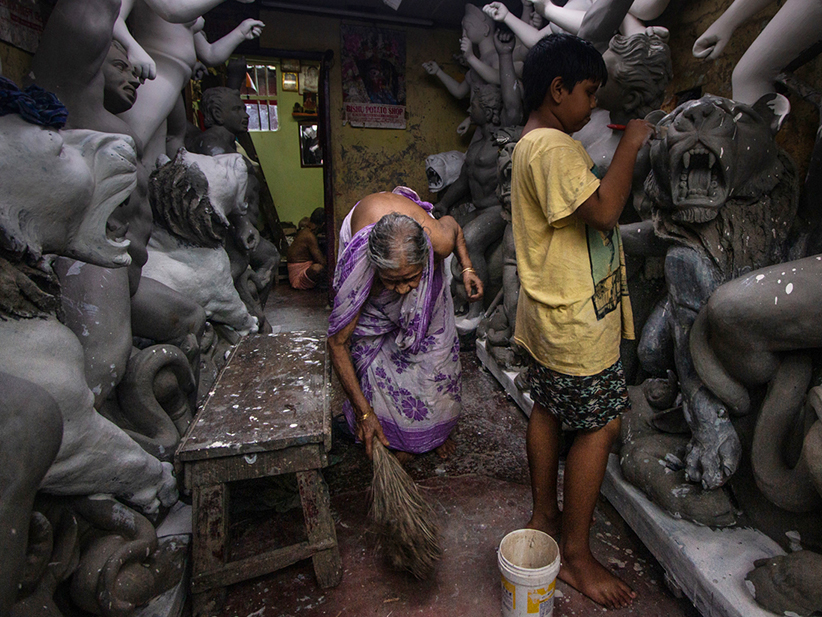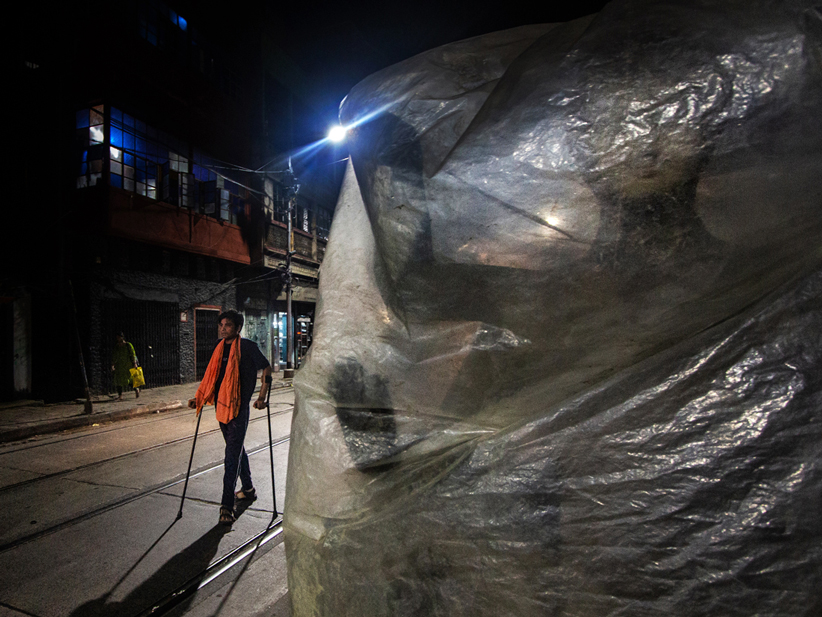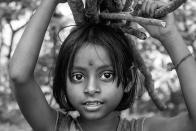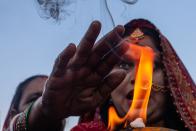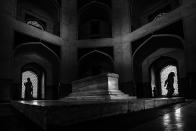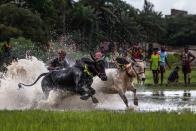Kumortuli - The Birth Place of Gods
Kumortuli - The Birth Place of Gods


“Debotar Janmo” is a famous story written by ShibramChakraborty. The story has nothing to do with my content but I find no better name to describe Kumortuli. God is the supreme creator, curator and commander of the universe. And then, the supreme power takes shapes in different forms familiar to us. Kumortuli – the abode where deities are born!
History
Kumartuli or Kumortuli is a famous place in North Kolkata. This is a place where both deities and devils get shapes before a journey from their heavenly abode to the devotees on the earth. God creates us and we create God – a token and celebration of mutual interdependence!
In Bengali, kumar or kumor means potter and tuli means locality. The history of Kumortuli can be traced back to 1757. The year marks the Battle of Plassey, when the East India Company handed defeat to then Bengal NawabSirajud-Daulah. According to the local narratives, Raja Nabakrishna Deb from famous Sovabajar Raj Bari, sent an invitation to a potter in Krishnanagar, requesting him to settle in Kumortuli.
Over the passage of time, more artisans followed his footsteps and started living in the area. Soon it became a hub of potters and today, kumortuli is inhabited by nearly 150 families. The craft is still dominated by men, with a few exceptions of female sculptors.
Art & Heritage
The potters in Kumortuli have no professional training from any elite art school and college. However, artistry is in their DNA. The passion for modelling and sculpting runs in their family and they have adopted it as their profession. Talented and assiduous by heredity, the level of skill, sense and sensibilities they have can easily put them at par with the art-college graduates.
None of them owns a big studio. Each potter works in a few square feet of area, often partitioned by dirty or tattered tarpaulin. The silhouette of the creators and creations (the roles have certainly been reversed) on the makeshift dividers weave a surreal vibe that I find no words to describe. The alleys are too dingy to allow the sunlight to streak in. My camera went on clicking to freeze and fossilize some of these wonderful moments.
The work goes on round the year but reaches its peak on the eve of Durga Puja. The makeshift studios tucked into the dimly lit alleys running from Chitpur come alive with the round-the-clock work months before the Bengali Hindus’ biggest festival. The alleys are too dingy to allow the sunlight to streak in. Still, these alleys are the most well-known address in Kolkata, where deities saw the daylight.
South Kolkata’s modernity and vibrancy are opposite to North Kolkata’s rich cultural heritage. The skyscrapers dominate South Kolkata’s skyline whereas North Kolkata is dotted with neck-to-neck old styled buildings. It feels Kumortuli carries in its heart a lingering nostalgic rainbow of history and heritage, fiercely guarding its tradition and culture against the rapid wave of modernity.
But there are certain times a year when tradition and modernity are conveniently and convincingly weaved together with a sense of pride, prejudice and pomposity. These are puja times and the grandest of all is the four-day Durga puja festival that has received the prestigious UNESCO heritage tag.
Durga, Demons and Dens through My Lens
Despite being born and brought up in South Kolkata, I feel a deep spiritual connect to North Kolkata because of my being irresistibly drawn to heritage and history, cultural traditions and tapestry and sublime art and spirituality. I visit the place every year, walk with my camera through the rambling alleys, talk to the potters, watch their work and take clicks as many as possible. This year too, there won’t be any exception to my routine visit to Kumortuli ahead of Durga Puja.
The clicks in this blogs are from my last few years’ visits to the place. The first time I stepped in the meandering and narrow by-lanes, it strongly felt different from my familiar South Kolkata fervour. It was and still, is a different world where supernatural power in their mortal shapes share space with human beings. Potters are at work. Sipping tea from a glass or bhad (made of mud), they replenishtheir energy from time to time.
Last year, I visited the place nearly one month ahead of the festival. I saw them busy with their ‘final touch’. Due to several years of my visit, I know many of them by their names and have developed bonding with the familiar faces. Sitting on a side table or sometimes standing for hours, I watch them working from a close quarter. I am a witness to their artistry, agility and assiduousness, with which, they go on working day and night, day in and day out until the Gods are born.
The droplets of sweats, which resemble dews but for me, the pearls of their perseverance and pratibha (talents), look bright in light. What inspires them? Do they workonly for their bread and butter or it is coupled with joy of creativity or submission to spirituality? Or just all three? I asked some of them. “Bhakti nathaklechintar je mukti hoi na baba (Without devotion, there is no way to liberate your thoughts my son)” and I immediately understood what he meant.
After mud is delicately plastered on the painstakingly created structures of straw and thatch, these half-done models are left to dry in the sun. Sometimes, the clay heads are dried in front of fire. After that, these mud structures receive several coats of paints and then,are draped in gaudy clothes and adorned with ornaments. At many traditional pujas, the ornaments used to adorn devi are made of pure yellow metal. Resplendent the mother looks in her attire and adornments.
Transcending the barrier of religiosity, Durga Puja has become a festival of art, joy, colour and crowd. Devotees take pride in being a part of the biggest art carnival while celebrating women’s empowerment, experiencing divinity and seeking Goddess’s blessings. Durga idols sculpted at Kumortuliare in high demand from across the world, wherever Bengalis live and celebrate this festival.
Vans and lorry are used for local, intra-city and intra-state transportation of idols. With puja round the corner, you can see many idols are awaiting their journey to the destinations. Van drivers wait in queue with their carts outside Kumortuli. Goddess is coming; it is the best time for them to earn some extra money. After all, they also have tobuy their children new dresses for pandal hopping.
Nearly all idols are sold out; only a few are left. Potters now have got some time for rest and refresh. They are sitting with deadpan stares, looking dejected and depressed despite having tucked-away notes for their work. How can a father look happy after bidding adieu to his daughter whom he has created and nourished so long with love and care? This is the relationship he finds and forms with his creations. This isan exemplary symbiosis and synthesis in the bonds between the creator and the creation, even when they lovingly do a role reversal.
Durga puja is just like a thread. It connects many people, from skilled sculptors to garment sellers to pandal decorators to van drivers to a photographer like me. The devi is a fulcrum thought, around which, we revolve with the purpose of making money, pride of creativity and pompousness of celebration. From Mud and Mundaneness to the Mother and Magic – that is what Kumortuli means in these potters’ life.
This placehas witnessed the rise of many eminent sculptors in Bengal. It is still an enigma how without professional training, these artisans craft stunning idols from mud and despite so many odds, have managed to survive their crafts and culture and even pass the baton to their future generations. Who am I to deny the divine blessing in their life?
The transformation from Mud to Murti to Divinity starts here, at Kumortuli.
